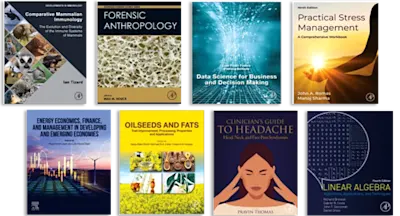
Whooping Cranes: Biology and Conservation
Biodiversity of the World: Conservation from Genes to Landscapes
- 1st Edition - September 4, 2018
- Editors: Philip J. Nyhus, John B French, Sarah J. Converse, Jane E. Austin
- Language: English
- Hardback ISBN:9 7 8 - 0 - 1 2 - 8 0 3 5 5 5 - 9
- eBook ISBN:9 7 8 - 0 - 1 2 - 8 0 3 5 8 5 - 6
Whooping Cranes: Biology and Conservation covers one of the most endangered birds in North America, and the subject of intense research and highly visible conservation activity.… Read more

Purchase options

Institutional subscription on ScienceDirect
Request a sales quoteWhooping Cranes: Biology and Conservation covers one of the most endangered birds in North America, and the subject of intense research and highly visible conservation activity. The volume summarizes current biological information on Whooping Cranes and provides the basis for future research necessary for conservation of this species.
This edited volume concentrates on work completed in the past 20 years in the areas of population biology, behavior and social structure, habitat use, disease and health, captive breeding, and Whooping Crane conservation. Much of the information presented comes from the study and management of remnant and reintroduced populations of Whooping Cranes in the field; some information is from experimentation and breeding of captive Whooping Cranes.
Whooping Cranes: Biology and Conservation
seeks to inform and galvanize action dedicated to meeting the challenges faced by Whooping Crane managers and conservationists. Thus, it describes one model of endangered species conservation and restoration that will interest a wide audience: professionals that work on cranes; researchers in the fields of small population biology, endangered species, and avian ecology; wildlife veterinarians and those involved in avian husbandry; administrators of management agencies or conservation organizations; conservationists in other fields; teachers of conservation biology or ornithology and their students; and the educated general public.- Presents a comprehensive treatment of the biology and ecology of Whooping Cranes, including biology of both remnant and reintroduced populations of Whooping Cranes
- Describes efforts over the past 45 years on conservation and the challenges of reintroducing an endangered species
- Includes chapters from a variety of disciplinary and scale perspectives, ranging from evolution, to population ecology, behavior, habitat use, large landscape conservation, conflict, and conservation efforts
- Features contributions that are readable, yet technically complete and fully referenced
- Provides an example of partnership and collegial action that integrates information produced by scientific research and operational wildlife management
- Edited and written by the leading Whooping Crane scholars and practitioners focused on this high-profile species of conservation concern
Professionals who work on cranes, including researchers in the fields of small population biology, endangered species, conservation, genetic management, avian breeding biology, wildlife veterinarians, captive breeding, habitat management, those involved in husbandry; administrators of management agencies or NGOs; conservationists in other fields; teachers of Conservation Biology or Ornithology and their students; and scholars, practitioners, decision-makers, students, and individuals interested in understanding the complex challenges and opportunities to conserving and restoring the world’s biological diversity
1. Whooping Cranes Past and Present
JOHN B. FRENCH, SARAH J. CONVERSE, JANE E. AUSTIN
2. Phylogenetic Taxonomy of Cranes and the Evolutionary Origin of the Whooping Crane
CAREY KRAJEWSKI
3. Revisiting the Historic Distribution and Habitats of the Whooping Crane
JANE E. AUSTIN, MATTHEW A. HAYES, JEB A. BARZEN
4. Population and Breeding Range Dynamics in the Aransas-Wood Buffalo Whooping Crane Population
SCOTT WILSON, MARK BIDWELL
5. Monitoring Recruitment and Abundance of the Aransas-Wood Buffalo Population of Whooping Cranes: 1950–2015
BRADLEY N. STROBEL, MATTHEW J. BUTLER
6. Mortality in Aransas-Wood Buffalo Whooping Cranes: Timing, Location, and Causes
AARON T. PEARSE, DAVID A. BRANDT, BARRY K. HARTUP, MARK BIDWELL
7. Population Dynamics of Reintroduced Whooping Cranes
SARAH J. CONVERSE, SABRINA SERVANTY, CLINTON T. MOORE, MICHAEL C. RUNGE
8. Reproductive Failure in the Eastern Migratory Population: The Interaction of Research and Management
SARAH J. CONVERSE, BRADLEY N. STROBEL, JEB A. BARZEN
9. Florida’s Nonmigratory Whooping Cranes
TIM A. DELLINGER
10. Pairing Dynamics of Reintroduced Migratory Whooping Cranes
RICHARD P. URBANEK, EVA K. SZYSZKOSKI, SARA E. ZIMORSKI, LARA E.A. FONDOW
11. Movement Ecology of Reintroduced Migratory Whooping Cranes
THOMAS MUELLER, CLAIRE S. TEITELBAUM, WILLIAM F. FAGAN, SARAH J. CONVERSE
12. Ecological Energetics of Whooping Cranes in the Eastern Migratory Population
MEGAN J. FITZPATRICK, PAUL D. MATHEWSON, WARREN P. PORTER
13. Winter Habitat Ecology, Use, and Availability for the Aransas wood Buffalo Population of Whooping Cranes
ELIZABETH H. SMITH, FELIPE CHAVEZ-RAMIREZ, LUZ LUMB
14. Habitat Use by the Reintroduced Eastern Migratory Population of Whooping Cranes
JEB A. BARZEN, ANNE E. LACY, HILLARY L. THOMPSON, ANDREW P. GOSSENS
15. Ecological Implications of Habitat Use by Reintroduced and Remnant Whooping Crane Populations
JEB A. BARZEN
16. Advances in Conservation Breeding and Management of Whooping Cranes (Grus americana)
SANDRA R. BLACK, KELLY D. SWAN
17. Reproduction and Reproductive Strategies Relevant to Management of Whooping Cranes Ex Situ
NUCHARIN SONGSASEN, SARAH J. CONVERSE, MEGAN BROWN
18. Health of Whooping Cranes in the Central Flyway
BARRY K. HARTUP
19. Health and Disease Treatment in Captive and Reintroduced Whooping Cranes
GLENN H. OLSEN, BARRY K. HARTUP, SANDIE BLACK
20. Rearing and Release Methods for Reintroduction of Captive-Reared Whooping Cranes
BARRY K. HARTUP
21. The Operation of an Aircraft-Led Migration: Goals, Successes, Challenges 2001 to 2015
JOSEPH W. DUFF
22. Louisiana Nonmigratory Whooping Crane Reintroduction
SAMMY L. KING, WILL SELMAN, PHILLIP VASSEUR, SARA ZIMORSKI
23. Whooping Crane Shootings Since 1967
ELISABETH CONDON, WILLIAM B. BROOKS, JULIE LANGENBERG, DAVIN LOPEZ
24. Future of Whooping Crane Conservation and Science
SARAH J. CONVERSE, JOHN B. FRENCH, JANE E. AUSTIN
- No. of pages: 538
- Language: English
- Edition: 1
- Published: September 4, 2018
- Imprint: Academic Press
- Hardback ISBN: 9780128035559
- eBook ISBN: 9780128035856
PN
Philip J. Nyhus
JF
John B French
SC
Sarah J. Converse
JA